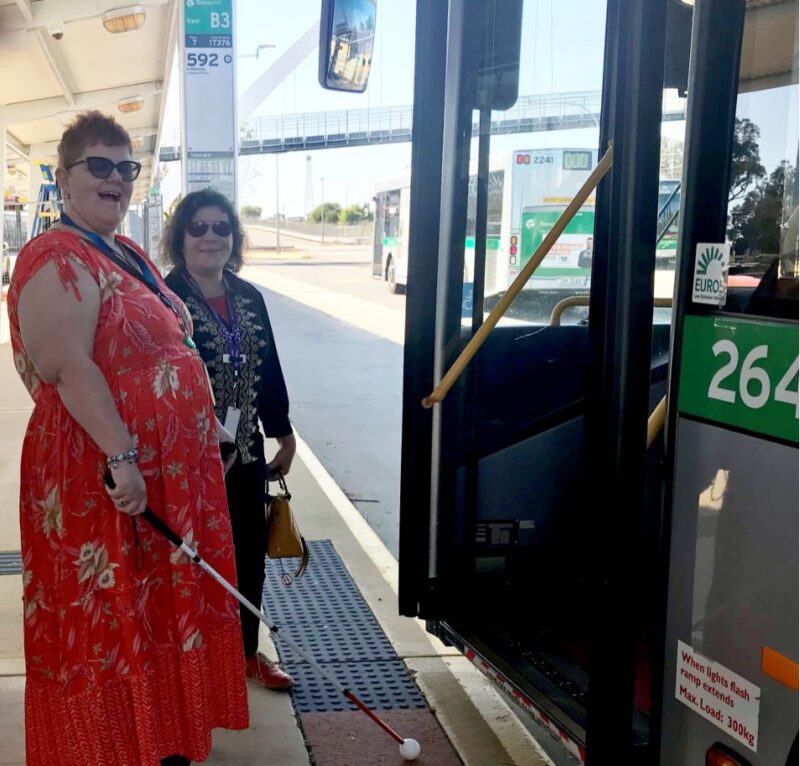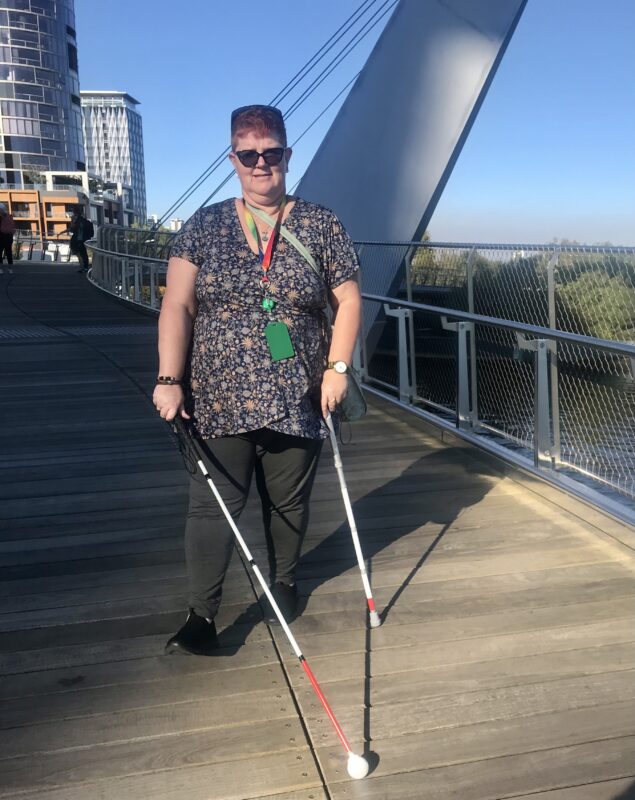Have you struggled to accept a white cane? If so, you’re not alone. For people with low vision, there can be a psychological barrier to using a white cane. It’s a deeper acknowledgement of your condition and accepting that you need support.
What many people don’t realise is that a cane will give you greater independence and freedom. That’s where our Orientation and Mobility (O&M) team can help. O&M Instructors provide advice on technique, holding and manoeuvring your cane, and gliding and tapping motions. They can also support you with route training to and from work or the shops, and to overcome anxieties and fears, so you have the confidence to use a white cane every day.

From denial to acceptance
Joanne Young, from Palmyra, has been receiving orientation and mobility support after losing her sight through a hereditary condition called lattice corneal dystrophy (link opens in new window) (LCD). Over the past four years, Joanne’s vision has becomes cloudy and blurred.
Joanne’s condition is more complex because she also has a cornea graft on her left eye. It means she has no peripheral vision and her eyes easily tire and get sore.
“I find that objects blur together, so it’s tricky to see steps and poles. I’ve been known to put on the wrong shoes because they are a similar colour. I’ll end up with one dark grey shoe and the other black.”
Joanne, VisAbility client
Joanne lives with her partner and her eleven-year-old son, who has autism. She calls her partner a ‘tower of support’.
“I wouldn’t accept a white cane for a long time and resisted it because I didn’t want to acknowledge my condition. I spent a lot of time in my own home, not venturing out,” Joanne explains.
“But one day I just thought ‘stop sulking’ and just do it, so I organised some orientation and mobility sessions with VisAbility instructor Anne-Sophie.”

White cane mobility
Anne-Sophie says because of Joanne’s condition, she suggested she use two canes, one for probing and the other for balance.
“Joanne uses a standard probing long white cane with a big ball. It’s good for outdoors because it’s lightweight, long enough to reach ahead, and slides easily across the ground. But she also needs a support cane because of her vertigo.”
Anne-Sophie, O&M instructor
There are many different types of white canes available. The standard probing long white cane that Joanne uses can detect any hazards or obstacles ahead of her. These can be steps, public bins, lamp posts, tactile markings, and escalators. The support cane is similar to a walking cane and aids balance. Smaller white canes are useful around the house.
“From early on Anne-Sophie set me targets. Initially, we’d go outside and walk around the drive, then it was up and down the street and eventually around the block,” Joanne says.
Building confidence
After a while, Joanne had enough confidence to use public transport. Joanne would get on a train and arrange to meet Anne-Sophie at places such as Fremantle and then Mandurah. Read our tips for using public transport if you live with vision impairment.
“I felt pretty empowered doing those longer trips on my own. I have a lot of eye appointments, so we’d also arrange a mock run-through, these were dry runs so I could familiarise myself with routes.”
VisAbility has also been involved in advising Joanne about home modifications.
“I’ve now got ramps around the house to make life easier. It means I can easily put clothes on the line or tend to my plants. I’m a keen gardener with hanging baskets and colourful borders.”
What words of advice would she offer to anyone else reluctant to use a cane?
“Don’t be stubborn, embrace and accept a white cane. My white cane offers me reassurance and security and has opened up a world of possibilities. Once you have that cane and you’ve undergone some orientation and mobility sessions, you can only go onwards and upwards.”
How to get support
Please complete the form below to make an initial enquiry about the white canes, our low vision services and support we can provide. Our Client Experience Team will contact you to discuss your individual needs both now and into the future.
